Gardening for Dinosaurs: Paleozoic Plants for Today
When you think of a classic garden, you might picture an impressionist painting. But let’s try turning the clock just a little further back… or, you know, like 300,000,000 years back. While the trilobites of the Paleozoic era and the overgrown chickens of the Jurassic may be long gone, some of the plants that dominated way back then are still alive and even thriving today.
These “living fossils” can tell us a lot about the fascinating adaptations that plants have come up with. Scientists can study the advent of seeds, the development of different ways of transporting water and nutrients, and the intricate coevolution of flowers and pollinators through living species and extinct ancestors.
The abundance of plants alive today reminds us that evolution is about diversity and adaptation, not “progress.” Ancient spore-bearing mosses still thrive very nicely right alongside the latest in flowering plants.
Aside from all that science stuff (undeniably awesome as it is), creating a dino garden is an exciting concept in its own right! And the good news is, you probably already have some truly 'retro' plants in your garden or neighborhood, whether you know it or not.
Let’s take a look back through time at just a few living fossils that still thrive today. We’ll start with one of the oldest living plant families, and one of the most ubiquitous.
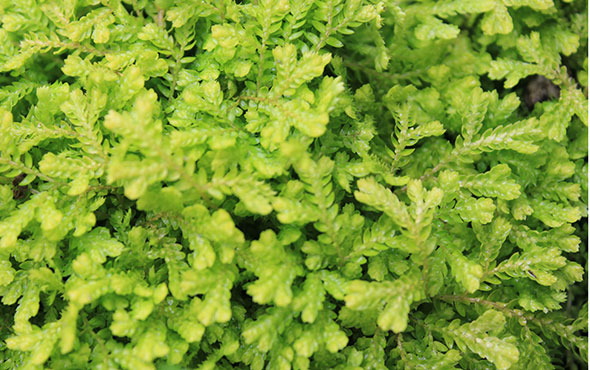
Mosses: Rugged Minimalists
↓ PALEOZOIC ERA - 450 Million Years Ago
Silurian Period - Early Fish & Corals
Mosses, like the golden spike moss pictured above, were among the very first plants to grow on land, and they are still thriving today using the exact same strategies as their ancient ancestors. The earliest known moss fossil dates to about 320 million years ago, when amphibians and insects ruled the land and sea life proliferated. But they may have been around much earlier. In fact, many scientists now believe that mosses and liverworts kicked off a chain reaction that led to mass extinction and an ice age, over 450 million years ago!
Mosses do things a little differently than the modern plants we may be more familiar with. Instead of self-contained seeds, they rely on water to disperse their spores. Instead of roots, they use fibers called rhizoids to hold themselves in place. They have no use for complicated systems of moving water and nutrients around, and instead absorb them directly through their leaves.
Nonetheless, these inconspicuous, ancient minimalists of the plant world are doing very well for themselves in modern times. Over 12,000 species survive today, living in diverse habitats all over the world.
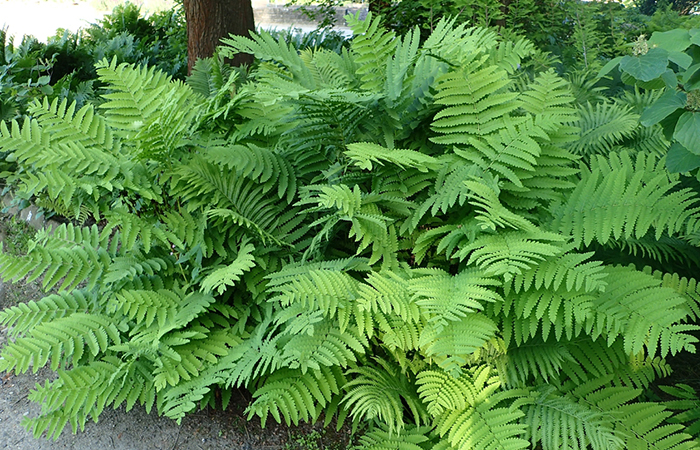
Ferns: Reaching for the Sky
↓ PALEOZOIC ERA - 360 Million Years Ago
Devonian Period - Early Insects & Amphibians
The very first ferns appear in the fossil record about 360 million years ago. This was the Devonian period, when plant and animal life on land was really starting to take off. Like mosses and other even earlier plants, ferns have spores instead of seeds, and rely on water for reproduction. But unlike those very first land plants, ferns can regulate the flow of water and nutrients through their systems. This allows them to grow much taller than mosses can.
Today, there are over 10,000 living species of ferns. And some of those species have been around for a while, to say the least. For example, Osmunda claytoniana (interrupted fern) dates back to the Triassic period, 180 million years ago. Talk about “tried and true”!
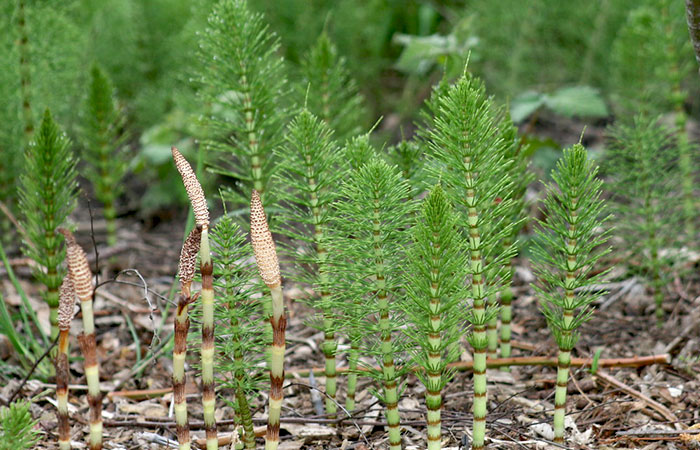
Horsetail: That’s One Tenacious Weed!
↓ PALEOZOIC ERA - 350 Million Years Ago
Carboniferous Period - Early reptiles (long before dinosaurs!)
If there’s one group that demonstrates the tenacity of ancient plants, it’s probably horsetails. Horsetails have been going strong since the dawn of the very first reptiles about 350 million years ago, and close relatives of the ones we are still pulling out of our flower beds today were once nibbled by hungry dinosaurs.
Like their relatives the true ferns, horsetails have vascular systems for moving water around, but stick to the old-school method of reproducing by spores rather than seeds. A vast diversity of horsetails dominated the understory of the earliest forests, with some towering up to 100ft tall! Ancient horsetails were so prevalent and dense that their remains make up a huge portion of the coal deposits that can still be found today.
Today, about 20 species of horsetail remain. These remnants of horsetail diversity make up the genus Equisetum, which is the only living genus in the botanical sub-class Equisetopsida.
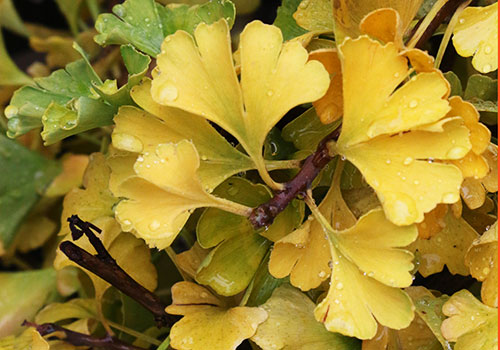
Ginkgo: The Not-So-Missing Link
↓ PALEOZOIC ERA - 290 Million Years Ago
Permian Period - Lots & lots of reptiles!
Ginkgo biloba, which most of us know as simply “ginkgo,” is another remnant of a once-diverse and very old lineage. In this case, just this one single species is the last of its class. That makes it also the last species of its order, family, and genus — all more specific categorizations.
Ginkgo plants that are very similar to the species still alive today show up in the fossil record as early as 290 million years ago. At that time, they were found all around the world, and they would have provided food and shelter to the reptiles that eventually gave rise to dinosaurs, and to the early ancestors of mammals. Maybe those old-timey critters even liked the taste of ginkgo's notoriously stinky fruit.
Those fruits enclose a nut-like seed, and gingkos were among the relatively early adopters of the whole seed idea: The very first true seeds show up in the fossil record about 30 million years before the first gingkos. Seed plants were able to diversify into new habitats, and they provided new sources of food that led to a proliferation of land animal species as well.
Today, ginkgo is commonly known as an incredibly resilient landscape tree. It is often used to line streets or adorn park paths because it can stand up to almost anything. Gardeners love it especially for its golden fall foliage. Many people also seek out the seeds or leaves for their reported medicinal properties.
But common as ginkgo might seem, it’s also important to scientists because of its unique biology. Its pollen is produced by cones like a conifer, but its seeds are held inside of fruit-like structures, and a look at its pollen under a microscope links it to ferns, mosses, and algae.
So next time you pass one of these ubiquitous sidewalk trees, take the time to look closer: that resilient trunk is carrying an ancient legacy!
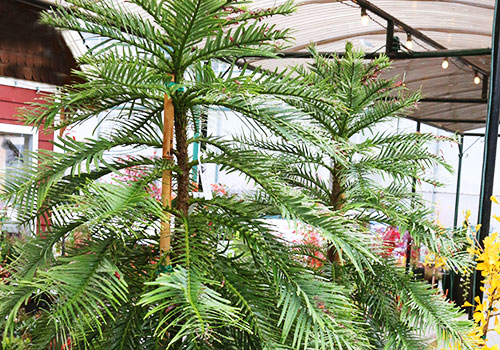
Wollemi Pine: A Rare & Ancient Treasure
MESOZOIC ERA - 200 Million Years Ago
Triassic Period - Early mammals & dinosaurs
The Wollemi Pine is a plant of mystery and the current unacknowledged winner of the international plant hide-and-seek competition. Thought to be extinct until only 26 years ago, it was rediscovered in 1994 by a rock climber hiking the temperate rainforests of southeastern Australia. The area has since been given restricted access and its specific location remains a secret to the public, in order to protect the rare plant from extinction. Because the Wollemi pine is considered endangered, efforts are being made to protect and propagate it, which has even made this rare plant available to us in Seattle!
This evergreen is a conifer, but not really a pine. Its distinctive knobby bark has been texturally compared to Cocoa Krispies cereal. Leaves are flat and broad, around 1.5 to 3” long. The plant will eventually develop seed cones that spread by wind dispersal. They prefer acidic soils and do well in a wide range of light levels from full sun to partial shade.
In Australia, potted Wollemi Pines are promoted as a unique Christmas tree option and can live nearly indefinitely in a pot, making them great for container and patio gardening. It even tolerates air conditioning and can be grown as an indoor plant as well. It grows slowly in a pot and can take up to 25 years to reach just 20 ft in height. Some of its close relatives are Norfolk Island Pines (a plant we often see in our indoor department) and Monkey Puzzle trees, which we'll talk about next.
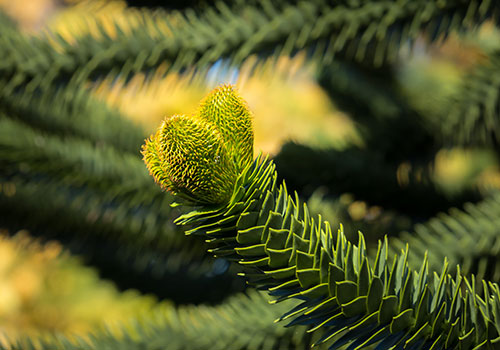
Monkey Puzzle Tree: AKA Dino Snacks
↓ MESOZOIC ERA - 150 Million Years Ago
Jurassic Period - Early birds & ocean reptiles
Conifers were also among the earliest seed plants, and some of the conifers we still know and love today have been around for quite a long time. The monkey puzzle tree (Araucaria araucana) is one particularly fun and unique example.
Today, this odd-looking tree graces many whimsical landscapes, and grows wild in its native range from the Chilean coast to the Andes. But 150 million years ago, it was just another source of dinosaur food.
You may have noticed that we’ve been going in chronological order, and the arrival of the monkey puzzle tree brings us to the era of those famous dinosaurs featured in The Land Before Time and Jurassic Park. Littlefoot’s long-necked family, or at least the real-life dinos they were based on, probably enjoyed browsing these up to 160ft tall trees.
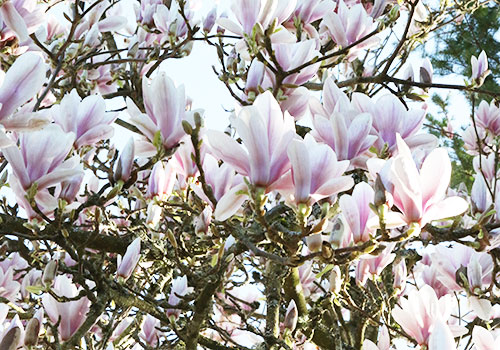
Magnolias: At Long Last, Flowers!
↓ MESOZOIC ERA - 100 Million Years Ago
Cretaceous Period - The first flowering plants
In terms of geological time, flowers are a fairly recent invention. But relative to a baby species like humans, the history of their development is still pretty ancient. And some of the earliest examples of flowering plants included close relatives of modern-day magnolias.
Evidence of the first flowering plants shows up in the fossil record about 130 million years ago. For perspective, that’s over 300 million years after those very first land plants we started with: Flowers are closer in the timeline to skateboards than to the first moss.
Early seed plants like conifers and ginkgos were (and still are) pollinated by wind. That’s a perfectly effective strategy, of course, but flowers created new opportunities to diversify by harnessing the pollination power of animals.
Once the whole flower idea got started, it really took off. Growing among abundant mammals, birds, and insects along with some of the most famous dinosaurs, flowering plants proliferated and diversified like wild.
Somewhere in the middle of all of this, about 100 million years ago, magnolias arrived on the scene. Those first magnolias were pollinated by beetles, just like their modern descendents, and they were once found just about everywhere. Cooling global temperatures reduced their range to a few areas in Asia and South America, where they luckily survived to give rise to the gorgeous flowering trees we enjoy today.
“Endless Forms Most Beautiful”
Today, flowering plants make up 90% of all plant species, even as conifers, ginkgos, horsetails, ferns, and mosses continue to thrive. There have also been even more innovations in plant evolution. For example, the first grasses that showed up with their unique strategies for pollination and photosynthesis less than 70 million years ago.
Gardeners take many different perspectives on their gardens, but not many of us try taking the perspective of a paleontologist. If you’ve never tried it, maybe now’s the time! How many different eras of plant evolution can you find in your own backyard?
Written by Toby Madrone, Research by Laurel Miles
